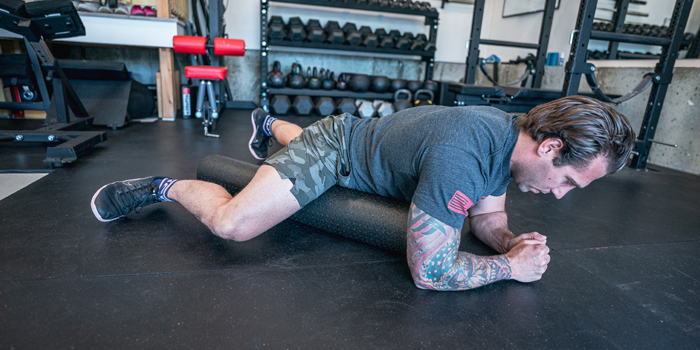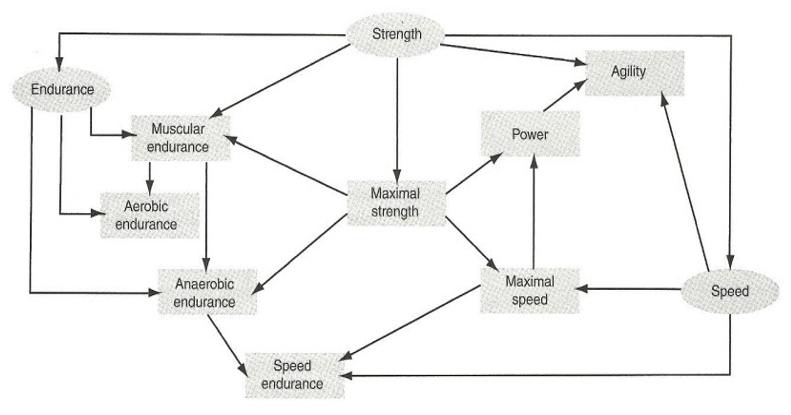
1. Prioritize Strength Training
HOW TO DO IT
Focus your strength training around the six foundational movement patterns (below), and then add in your accessory movements afterward to assist in the big movements.
It’s important to note that strength provides the basis for success across multiple modalities, increased resiliency and longevity, connecting to every biomotor ability. Even if the goal isn’t necessarily to improve maximal strength (increasing your 1-rep max squat), there are still connections between maximal strength and other abilities such as strength endurance. For example, if your 1RM squat increases, it’s likely your 5RM will too. Improving your 5RM-squat well seldom carry over to your 1RM squat.

*Image courtesy of “Periodization” By Bompa & Haff
Moreover, there is much confusion about what strength training is, and not all forms of strength are created or developed the same way.
By definition, strength is “the ability to exert maximal force,” but let's look at strength from more of a holistic approach encompassing all tools that improve it—directly and indirectly.
With that said, our model of “strength training” allows us to improve:
- Body composition
- Muscular imbalance and posture
- The strength of smaller muscle groups that assist in complex movements, allowing our athletes to perform complex movements with less risk of injury
- Neuromuscular efficiency—allowing your athletes to actually use more muscle fibers to generate more force
Again, strength equals resiliency. EVERYTHING else is easier, from lifting a heavy load to running a 5k. Considering the posture of most of our clients (sitting at a desk or with an iPhone in hand), it makes sense that the backside needs work.
NEW: 20 Tips to Improve Your Training
Your strength work should be centered around six foundational movement patterns of squat, hinge, lunge, push, upper-body pull (vertical and horizontal), carry. Here’s a quick list of movements that encompass all six patterns:
- Landmine Split Squat
- Fat Bar Inverted Rows
- Glute Hip Thrust
- Cable Facepulls
- DB Floor Press
- Reverse Band Trap Bar RDL
- Front Rack Barbell Carry
- Box Squat
- Trap Bar Deadlift
- Landmine Lateral Squat
While this is not meant to be an exhaustive list, it showcases some staple exercises that will transform your client’s physiques while bolstering strength capacity. We don’t just use novelty and variations in our programming aimlessly; we work on programming them all more intelligently.
2. Implement Cooldown Sequences
HOW TO DO IT
Add a cooldown to your training programs each day to get recovery started before they leave the gym.
What’s in a cooldown? A lot! In fact, this is one of the bigger changes we’ve made to our programming to include measures that ANYONE can do after their training session to drive recovery via the parasympathetic nervous system.
Oftentimes clients “want more,” extending their training sessions beyond the 60-minute mark only to increase cortisol. People would be better served to focus on improving their recovery, not to mention their sleep patterns. We can certainly control the implementation of easy recovery measures.
For example, once we’ve concluded our training session, it’s the perfect time to use foam rolling to enhance lymphatic drainage. This foam rolling is done globally on large/dense musculature with six to twelve inches of motion.
Positional parasympathetic breathing drills done for fifteen breaths adds the cherry on the sundae and drives the parasympathetic nervous system. Here are some examples of cool down work based on the above six-phase warm-ups:
Cooldown Protocol
- Global Foam Rolling: Six to twelve inches of relative motion rolling proximal to distal. This is done on the same musculature you foam roll in your warm-up, but now the execution is different to expedite recovery.
- Parasympathetic Breathing Drills: 15 Breaths with a 6-second inhale + 1-second hold +6 seconds exhale +1 second hold at the bottom
The cooldown allows us to build our clients' recovery up as much as our training is strategically breaking them down. And a more recovered client means a healthier client in both the short-term and long-term in a day and age where chronic burnout and injuries have become the norm.
3. Aerobic Systems Development
HOW TO DO IT
Add aerobic conditioning to your training programs each week.
Going balls to the wall daily is a one-way ticket to overtraining, and the methodology that too many subscribe to. Don’t be fooled by social media. There is a point of diminishing returns, and it’s likely if you’ve been around the block a few times, you’ve experienced this.
A better approach is knowing the difference between the aerobic and anaerobic systems, how the two overlap and in just about every single conditioning piece, and how we can improve the two most effectively.
The best possible option is to focus on building the base of fitness, which is the aerobic system. The aerobic system affords us the ability to recover better and LIVE LONGER. It’s pretty well established via multiple studies, showing the connections between endurance and lifespan and something I talked about in my last article, “3 Conditioning Methods To Use With Conjugate.” Without an efficient aerobic system, you’re leaving gains on the table.
My best advice to you would be to:
- Include the Cardiac Output Method AT LEAST once a week in your plan. This is cyclical style work, i.e., light row, jog, run, light sled pull for 30+ minutes with a heart rate of 130-150BPM (conversational). This will carry over like you wouldn’t believe to other modalities.
- Include more work to rest conditioning pieces. If you’re not programming planned rest in at least one to two conditioning sessions a week, improving work capacity long-term will be tough to do.
- Understand the connection between the amount of muscle worked with a given movement and how that relates to spiking the heart rate.
List of benefits of improving the aerobic system:
- Improved recovery
- Improved sleep
- Improved ability to pump blood to the extremities
- Improved ability to replenish ATP for explosive movements
- Decreased resting heart rate
- Longer lifespan!
4. Varying Strength and Conditioning Too Often Can Be a Determent
HOW TO DO IT
Keep the same conditioning workouts and assistance exercises for a minimum of two weeks.
Let me be clear. I'm not saying that you should never vary your programming—quite the opposite, actually. The question is, when does too much variety become a disservice to ourselves and our clients? And if you only perform the same variation every eight to twelve weeks, it will be tough to improve movement and know whether that particular variation is a good one for YOU.
The conjugate method is built upon variability, but where this differs from a constantly varied model is the delivery of a training plan vs. workouts. There is a huge difference between performing random training sessions vs. planned training sessions.
The latter allows us to plan variability, and that variability may mean that we are changing exercise variations every two to three weeks vs. every week. By having a plan, we can ensure proper recovery between sessions and more structure with biomechanics. There is less chance of stressing the same joints daily, further decreasing the risk of injury.
In a nutshell, there is no question that there is a fine line between too much variability and not enough variability. What's important is knowing that some repetition is not the antichrist and can serve more than a few goals.
One caveat, if you're going to use different movements weekly, you'll want to start with two weeks before jumping to three. Psychologically this can be a tough shift for many, which is important to keep in mind.
Some may actually like the 2-week rotation more and feel it's enough to reap the benefits. While this may be true, I'd recommend at least trying a three-week rotation before deciding which path to go.
And even if we know for a fact that 3-weeks will yield more results, some people have too much exercise ADHD to adhere to that, so you'll have to tailor your approach to the individual as we know there IS no one-size-fits-all.
Lastly, if you're an advanced athlete or working with more advanced clients using the max effort method, you'll still want to rotate true ME work weekly. This is the one exception to that rule, but if you're programming for less experienced clients, using the same bilateral movements will allow you to really ingrain good motor patterns.
5. Avoid Linear Periodization
HOW TO DO IT
Use a concurrent model of training that allows for ebb and flow of life.
"Linear periodization is like going 3/4 the way up the mountain and turning around before you reach the top." —Louie Simmons
Over the last ten years, we've experimented with linear periodization in our programming but always found more drawbacks than benefits, not to mention the results have paled compared to using conjugate periodization.
I'm not saying linear periodization will not work; I believe anything will work, but there is a long list of variables to consider before deciding the best course of action regarding your approach to program design.
Additionally, I'm biased now because of my experience and success with tens of thousands of athletes worldwide who use my programming.
My bias revolves around concurrent training, in which the conjugate system provides the framework of all of our programming, regardless of the client's goals.
Moreover, I am talking specifically about programming that is delivered for general fitness where we can make gains in strength, conditioning, and body composition concurrently.
Linear periodization has its place for certain individuals, and I've used it with varying levels of success. Still, overall there are too many drawbacks when the big picture is considered.
There are many variables to consider within any program design, the first one being our clients' schedules and lives outside of the gym.
Potential Linear Periodization Drawbacks
- Oftentimes, in an effort to develop one quality, you neglect other areas of fitness. For example, it's not uncommon to see losses in maximal strength when strength-endurance is targeted. Similarly, when power development is targeted, it's not uncommon to see losses in muscular hypertrophy.
- Accommodation to the same movements, for most, will occur at different rates, meaning the point at which you begin to accommodate to the same movement pattern is the same point at which you start to go backward with your progress. This is why I'm a big fan of rotating variations for max effort and dynamic effort regularly. Overuse injury can be more prevalent. It's not unreasonable to think that if you're performing the same movement patterns every week with increasing levels of intensity that you will inevitably compensate, exacerbating faulty motor patterns, thereby increasing the risk of injury.
- The overall success of your cycle is highly dependent on consistency, so if you miss a week for whatever reason (which is quite common if you have a family and other responsibilities), the results can be significantly different.
- Let's not forget that performing the same movements week in and week out is downright boring. Most are drawn to conjugate love novelty and rotations of movement patterns.
- Percentages do not take into account individual muscle-fiber type (Type 1 vs. Type 2). Performing two sets of two with 90 percent of a 1RM for some of your endurance athletes may be relatively smooth. In contrast, your fast-twitch and explosive athletes will have difficulty performing doubles (even for two sets) with 90 percent.
- Auto-regulation is critical to staying healthy and aligning your training to how you're feeling on a given day. With a linear maximal strength cycle, the given percentages may not be reasonable if other stressors in your life are taking a toll. Has 85percent of your 1RM ever felt like 100 percent? Having moments of simply feeling like shit or when your trainability is less than optimal needs to be managed. With conjugate, our maximal work is a max ON THAT DAY, not based on an all-time personal record when things were feeling good! Being able to make game-time adjustments is a key tenet of training smarter.
Closing
These five key areas will not only improve your and your clients’ results but, more importantly, their ability to stay injury-free while staying motivated to train. One of the biggest misconceptions I see is coaches not making the connection between loss of motivation to train and overtraining—the two are synonymous. But expediting recovery via cooldowns and aerobic development, improving how people look and feel via strength work with the six foundational patterns, and replacing the monotony of linear cycles with a more realistic model like concurrent model like conjugate (that ebbs and flows with the variability of life), the chances of success increase exponentially.
Header image credit: RX Photography











https://www.ajinomoto.com/aboutus/amino_acids